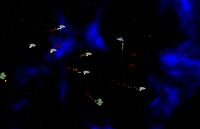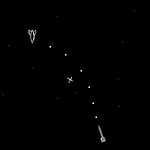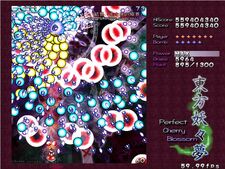
A typical shoot 'em up, featuring spacecraft and a side-scrolling viewpoint.
Shoot 'em up (also known as shmups) is a subgenre of shooter video games. In a shoot 'em up, the player controls a lone character, often a spacecraft, shooting large numbers of enemies while dodging their attacks. The genre in turn encompasses various types or subgenres and critics differ on exactly what design elements constitute a shoot 'em up. Some restrict the definition to games featuring spacecraft and certain types of character movement; others allow a broader definition including characters on foot and a variety of perspectives. Shoot 'em ups call for fast reactions and for the player to memorise levels and enemy attack patterns. More difficult games feature overwhelming amounts of enemy projectiles, the patterns of which the player must memorise in order to avoid.
The genre's origins can be traced back to Spacewar! one of the very earliest computer games, developed in 1961 and eventually released in arcades in the early 1970s. However, Space Invaders, released in Japanese arcades in 1978, is generally credited with inventing the genre proper, as well as popularising it. Shoot 'em ups were popular throughout the 1980s and early 1990s as they evolved. From the mid-1990s and the burgeoning use of 3D graphics in video games, shoot 'em ups became a niche genre based on design conventions established in the 1980s and increasingly catered to specialist enthusiasts, particularly in Japan.
Shoot 'em ups encompass various types, or sub-genres. In a "fixed shooter", such as Space Invaders, the protagonist can only move across one axis and enemies attack from a single direction. In a "multi-directional shooter" the protagonist may rotate and move in any direction. In contrast, in a "rail shooter" the protagonist is viewed from behind, moving "into the screen" while the player has control over dodging. "Tube shooters" feature similar viewpoints, with the protagonist flying through an abstract tube. "Scrolling shooters" encompass both "horizontal shooters" and "vertical shooters" (featuring side-on and top-down viewpoints respectively) and in turn "bullet hell" games and "cute 'em ups", while "run and gun" games feature protagonists on foot, rather than spacecraft, often with the ability to jump; they may feature either scrolling or multidirectional movement.
Definition[]
A "shoot 'em up", also known as a "shmup",[1][2] is a game in which the protagonist combats a large number of enemies by shooting at them while dodging their fire. The controlling player must rely primarily on reaction times to succeed.[3][4] Beyond this, critics differ on exactly which design elements constitute a shoot 'em up. Some restrict the genre to games featuring some kind of craft, using fixed or scrolling movement.[3] Others widen the scope to include games featuring such protagonists as robots or humans on foot, as well as including games featuring "on-rails" (or "into the screen") and "run and gun" movement.[4][5][6] Formerly, critics described any game where the primary design element was shooting as a "shoot 'em up",[4] but later shoot 'em ups became a specific, inward-looking genre based on design conventions established in those 1980s shooting games.[5]
Design[]
Common elements[]

R-Type, a horizontal scroller. The protagonist is the small spacecraft on the left; the creature on the right is a powerful boss character.
Shoot 'em ups are a sub-genre of shooter game, in turn a type of action game. These games are usually viewed from a top-down or side-view perspective, and players must use ranged weapons to take action at a distance. The player's avatar is typically a vehicle that is under constant attack. Thus, the player's goal is to shoot as quickly as possible anything that moves or threatens him.[7] In some games, the player's character can withstand some damage; in others, a single hit will result in his destruction.[2] The main skills required in shoot 'em ups are fast reactions and memorising enemy attack patterns. Some games feature overwhelming amounts of enemy projectiles and the player has to memorise their patterns in order to survive.[1][8][9] These games belong to one of the fastest-paced video game genres.[7]
Large numbers of enemy characters are typically featured. These enemies may behave in a certain way dependent on their type, or attack in formations that the player can learn to predict. The basic gameplay tends to be straightforward and many games offset this with boss battles and a variety of weapons.[2] Shoot 'em ups rarely have realistic physics. Characters can instantly change direction with no inertia, and projectiles move in a straight line at constant speeds.[7] The player's character can collect "power-ups" which may afford the character greater protection, an "extra life", or upgraded weaponry.[8] Different weapons are often suited to different enemies, but these games seldom keep track of ammunition. As such, players tend to fire indiscriminately, and their weapons only damage legitimate targets.[7]
Types[]

A tube shooter, featuring craft flying through an abstract tube and viewed from behind the protagonist.
Shoot 'em ups are categorised by design elements, particularly viewpoint and movement:[4] "fixed shooters" consist of levels that each fit within a single screen. The protagonist's movement is fixed to a single axis of motion, and enemies attack in a single direction (such as descending from the top of the screen).[10] These games are sometimes also called "gallery shooters".[5] "Rail shooters" limit the player to moving around the screen while the game follows a specific route;[11] these games feature an "into the screen" viewpoint, with which the action is seen from behind the character.[4][12] "Tube shooters" feature craft flying through an abstract tube.[13]
"Scrolling shooters" include vertical or horizontal scrolling games. In a vertically scrolling shoot 'em up (or "vertical scroller"), the action is viewed from above and scrolls up (or very occasionally down) the screen. This has the advantage of allowing complex patterns of enemies as well as allowing even simple graphics to function convincingly. Vertical scrollers are best suited for arcade machines with tall screens; screens used with home computers or consoles tend to be wider than they are tall and thus less suited to vertical scrolling.[4] The other main type of scrolling shooter is a "horizontal shooter" or "side-scrolling shooter", in which the action is viewed side-on and scrolls horizontally.[4][5][14] A small number of scrolling shooters, such as Sega's Zaxxon, feature an isometric point of view.[5] Others dispense with scrolling altogether instead using a flip-screen device: when a player reaches the edge of the screen, a whole new scene appears at once.[4] Some shooters may feature multi-directional movement ("multi-directional shooter"), generally with a static screen.[15] "Bullet hell" (弾幕 danmaku, lit. "barrage" or "bullet curtain") is a shoot 'em up in which the entire screen is often almost completely filled with enemy bullets.[9] This type is also known as "curtain fire",[16] "manic shooters"[5] or "maniac shooters".[17] This style of game originated in the mid-1990s, and is an offshoot of scrolling shooters.[17] "Cute 'em ups" feature brightly coloured graphics depicting surreal settings and enemies.[5] Newer, particularly Japanese, cute 'em ups employ overtly sexual characters and innuendo.[18]
"Run and gun" (or "run 'n' gun") describes a shoot 'em up in which the protagonist fights on foot, perhaps with the ability to jump. Run and gun games may use side scrolling, vertical scrolling or isometric viewpoints and may feature multi-directional movement.[6][19][20] These types of games may also be termed "scrolling shooters".[21]
History[]
Origins and rise[]

Spacewar!, an early computer game featuring shooting and spacecraft.
The genre's exact origins are a matter of some confusion.[4] Ashcraft pinpoints Spacewar! (one of the very earliest computer games) as the first shoot 'em up[22] but the later Space Invaders is more frequently cited as the "first" or "original" in the genre.[4][5][23] Spacewar! was developed at the Massachusetts Institute of Technology in 1961, for the amusement of the developers; it was however remade four times as an arcade game in the early to mid-1970s. The game featured combat between two spacecraft, inspired by the contemporary Cold War space race.[22][24] However, it was not until 1978's seminal Space Invaders, created by Japan's Taito Corporation, that the genre became prolific. Space Invaders pitted the player against multiple enemies descending from the top of the screen at a constantly increasing rate of speed.[23] The game used alien creatures inspired by The War of the Worlds (by H. G. Wells) because the developers were unable to render the movement of aircraft; in turn the aliens replaced human enemies because of moral concerns (regarding the portrayal of killing humans) on the part of Taito Corporation. As with subsequent shoot 'em ups of the time, the game was set in space as the available technology only permitted a black background. The game also introduced the idea of giving the player a number of "lives". Space Invaders was a massive commercial success, causing a coin shortage in Japan.[25][26] The following year, Namco's Galaxian took the genre further with more complex enemy patterns and richer graphics.[5][27]
Golden age and refinement[]
In the 1980s, Defender introduced scrolling to shoot 'em up, offering horizontally extended levels. Unlike most later games in the genre, the player could move in either direction.[5] The following year, Konami introduced Scramble, a side scrolling shooter with forced scrolling. It was the first scrolling shooter to offer multiple, distinct levels.[5] Atari's Tempest, released in 1981, was one of the earliest tube shooters and an early attempt to incorporate a 3D perspective into shooter games.[28][29] Tempest ultimately went on to influence major rail shooters.[30][31] Vertical scrolling shooters emerged around the same time. Xevious (released in 1982) is frequently cited as the first vertical shooter and, although it was de facto preceded by several other games featuring vertical scrolling, it was the most influential.[5] Xevious was also the first to convincingly portray realistic landscapes as opposed to purely science fiction settings.[32] While Asteroids (1979) allowed the player to rotate the game's spacecraft,[33] 1982's highly acclaimed Robotron 2084 was most influential on subsequent multi-directional shooters.[34][35] Sega's Space Harrier, a rail shooter released in 1985, broke new ground graphically and its wide variety of settings across multiple levels gave players more to aim for than high scores.[36][37]
1985 also saw the release of Konami's Gradius. Gradius gave the player greater control over the choice of weaponry, thus introducing another element of strategy.[5] The game also introduced the need for the player to memorise levels in order to achieve any measure of success.[38] Gradius, with its iconic protagonist, defined the side-scrolling shoot 'em up and spawned a series spanning several sequels.[39] The following year saw the emergence of one of Sega's forefront series with its game Fantasy Zone. The game received acclaim for its surreal graphics and setting and the protagonist, Opa-Opa, was for a time considered Sega's mascot.[40] The game borrowed Defender's device of allowing the player to control the direction of flight and along with the earlier Twinbee (1985), was an early archetype of the "cute 'em up" sub-genre.[5][41] R-Type, another acclaimed side-scrolling shoot 'em up, was released in 1987 by Irem, employing slower paced scrolling than usual, with difficult levels calling for methodical strategies.[1][42] 1990's Raiden was the beginning of another acclaimed and enduring series to emerge from this period.[43][44]
Shoot 'em ups such as SNK's Ikari Warriors (1986) featuring characters on foot, rather than spacecraft, became popular in the mid-1980s in the wake of action movies such as Rambo: First Blood Part II.[45] The first game of this type is unknown but the first influential example was Data East's Commando, released in 1985.[20] Commando also drew comparisons to Rambo[46] and indeed contemporary critics considered military themes and protagonists similar to Rambo or Schwarzenegger prerequisites for a shoot 'em up, as opposed to an action-adventure game.[20] 1988's Contra (a modified version of which was released as Probotector in Europe) was particularly acclaimed for its multi-directional aiming and two player cooperative gameplay. However, by the early 1990s and the popularity of 16-bit consoles, the scrolling shooter genre was overcrowded, with developers struggling to make their games stand out (one exception being the inventive Gunstar Heroes, by Treasure).[47]
"Bullet hell" evolution and niche appeal[]

Perfect Cherry Blossom, a manic shooter featuring a vertical viewpoint. The game features overwhelming amounts of enemy projectiles, the patterns of which the player must memorise in order to dodge.
A new type of shoot 'em up emerged in the early 1990s: variously termed "bullet hell", "manic shooters" and "maniac shooters", these games required the player to dodge overwhelming amounts of enemy projectiles and called for still faster reactions from players.[5][17] Bullet hell games arose from the need for 2D shoot 'em up developers to compete with the emerging popularity of 3D games: huge numbers of missiles on screen were intended to impress players.[17] Toaplans's Batsugun (1993) provided the prototypical template for this new breed, with Cave (formed by former employees of Toaplan, including Batsugun's main creator Tsuneki Ikeda, after the latter company collapsed) inventing the type proper with 1995's DonPachi.[48] Manic shooter games marked another point where the shoot 'em up genre began to cater for more dedicated players.[5][17] Games such as Gradius had been more difficult than Space Invaders or Xevious,[38] but bullet hell games were yet more inward-looking and aimed at dedicated fans of the genre looking for greater challenges.[5][49] While shooter games featuring protagonists on foot largely moved to 3D-based genres, popular, long-running series such as Contra and Metal Slug continued to receive new sequels.[50][21][51] Rail shooters have rarely been released in the new millennium, with only Rez and Panzer Dragoon Orta achieving cult recognition.[11][37][52]
Treasure's shoot 'em up, Radiant Silvergun (1998), introduced an element of narrative to the genre. It was lavished with critical acclaim for its refined design, though it was never released outside of Japan and remains a much sought after collectors' item.[5][1][53][54] Its successor Ikaruga (2001) featured improved graphics and was again acclaimed as one of the best games in the genre. Unlike Radiant Silvergun, it was later released on Xbox Live Arcade.[5][1][55] The genre has undergone something of a resurgence with the release of the Xbox 360 and Wii online services,[55] while in Japan arcade shoot 'em ups retain a deep-rooted niche popularity.[56] Geometry Wars: Retro Evolved was released on Xbox Live Arcade in 2005 and in particular stood out from the various re-releases and casual games available on the service.[57] However, despite the genre's continued appeal to an enthusiastic niche of players, shoot 'em up developers are increasingly embattled financially by the power of home consoles and their attendant genres.[56][58]
References[]
- ↑ 1.0 1.1 1.2 1.3 1.4 Buchanan, Levi (April 8, 2008). "Top 10 Classic Shoot 'Em Ups". IGN. Retrieved on May 26, 2009.
- ↑ 2.0 2.1 2.2 Beck, Ian (May 19, 2006). "Jets'n'Guns". Inside Mac Games. Retrieved on July 20, 2008.
- ↑ 3.0 3.1 Ashcraft, p. 70
- ↑ 4.0 4.1 4.2 4.3 4.4 4.5 4.6 4.7 4.8 4.9 Bielby, Matt, "The Complete YS Guide to Shoot 'Em Ups", Your Sinclair, July, 1990 (issue 55), p. 33
- ↑ 5.00 5.01 5.02 5.03 5.04 5.05 5.06 5.07 5.08 5.09 5.10 5.11 5.12 5.13 5.14 5.15 5.16 5.17 5.18 Game Genres: Shmups, Professor Jim Whitehead, January 29, 2007, Accessed June 17, 2008
- ↑ 6.0 6.1 Provo, Frank, Bloody Wolf, GameSpot, July 7, 2007, Accessed June 17, 2008
- ↑ 7.0 7.1 7.2 7.3 Rollings, Andrew; Ernest Adams (2006). Fundamentals of Game Design. Prentice Hall. http://wps.prenhall.com/bp_gamedev_1/54/14053/3597646.cw/index.html.
- ↑ 8.0 8.1 Parkin, Simon (September 21, 2006). "Gradius Collection". EuroGamer. Retrieved on February 14, 2009.
- ↑ 9.0 9.1 Ashcraft, p. 66
- ↑ Provo, Frank Galaga '90, GameSpot, August 10, 2007, Accessed June 17, 2008
- ↑ 11.0 11.1 Goldstein, Hilary, Panzer Dragoon Orta, IGN, January 10, 2003, July 17, 2008
- ↑ Kalata, Kurt, Space Harrier, Hardcore Gaming 101, Accessed February 14, 2009
- ↑ Reed, Kristan, Gyruss, EuroGamer, April 19, 2007, Accessed February 17, 2009
- ↑ Smith, Rachael, "Sidewize," Your Sinclair, October 1987 (issue 22), p. 38
- ↑ Onyett, Charles, Crystal Quest, IGN, February 13, 2006, Accessed June 17, 2008
- ↑ Sheffield, Brandon, Q&A: Capcom's Kujawa On Revisiting Classics, Bullet Hell, April 22, 2008, Accessed March 2, 2009
- ↑ 17.0 17.1 17.2 17.3 17.4 Ashcraft, p. 77
- ↑ Ashcraft, p. 82
- ↑ Dunham, Jeremy, First Look: Alien Hominid, IGN, July 27, 2004, Accessed June 17, 2008
- ↑ 20.0 20.1 20.2 Bielby, Matt, "The YS Complete Guide To Shoot-'em-ups Part II", Your Sinclair, August 1990 (issue 56), p. 19
- ↑ 21.0 21.1 Magrino, Tom, Contra conquering DS, GameSpot, June 20, 2007, Accessed February 17, 2009
- ↑ 22.0 22.1 Ashcraft, p. 72
- ↑ 23.0 23.1 Buchanan, Levi, Space Invaders, IGN, March 31, 2003, Accessed June 14, 2008
- ↑ Surette, Tim, Gaming pioneer passes away, GameSpot, June 7, 2006, Accessed June 16, 2008
- ↑ Ashcraft pp. 72–73
- ↑ Design your own Space Invaders, Science.ie, 4 March 2008, Accessed 17 June 2008
- ↑ Buchanan, Levi, Galaxian Mini, IGN, April 21, 2003, Accessed June 17, 2008
- ↑ Roper, Chris, The Games of Atari Classics Evolved: Part 2, IGN, October 22, 2007, Accessed June 17, 2008
- ↑ Atari Arcade Classics, Play Video Games, Accessed March 2, 2009
- ↑ Terminator 3: The Redemption, Yahoo Games! Accessed March 2, 2009
- ↑ Leo, Jonathan, "Rez HD", GameAxis Unwired, March 2008, p. 47
- ↑ Ashcraft, p. 75
- ↑ Mielke, James, Asteroids Review, GameSpot, November 19, 1998, Accessed February 17, 2009
- ↑ Gerstmann, Jeff, Robotron: 2084 Review, GameSpot, December 20, 2005, Accessed February 17, 2009
- ↑ Staff, Top 10 Tuesday: Game Designers, IGN, Accessed February 17, 2009
- ↑ Buchanan, Levi, Space Harrier Retrospective, IGN, September 5, 2008, Accessed February 17, 2009
- ↑ 37.0 37.1 Maragos, Nich, Space Harrier (PS2), 1UP, January 1, 2000, Accessed February 17, 2009
- ↑ 38.0 38.1 Ashcraft, p. 76
- ↑ Kasavin, Greg, Gradius Collection Review, GameSpot, June 7, 2006 Accessed February 12, 2009
- ↑ Fahs, Travis, Fantasy Zone Retrospective, IGN, October 1, 2008, Accessed February 13, 2009
- ↑ Kalata, Kurt, Fantasy Zone, Harcore Gaming 101, Accessed February 13, 2009
- ↑ Todd, Brett, R-Type Dimensions Review, GameSpot, February 7, 2009, Accessed February 13, 2009
- ↑ Navarro, ALex, Raiden Review, GameSpot, November 17, 2004, Accessed February 13, 2009
- ↑ Buchanan, Levi, Raiden, IGN, February 17, 2004, Accessed February 13, 2009
- ↑ The History of SNK, GameSpot, Accessed February 16, 2009
- ↑ Segre, Nicole, "Commando," Sinclair User, February 1986 (issue 47)
- ↑ IGN's Top 100 Games, IGN, July 25, 2005, Accessed February 19, 2009
- ↑ Ashcraft, pp. 78-80
- ↑ Ashcraft, pp. 77-78
- ↑ Staff, Contra Q&A, GameSpot, October 1, 2002, Accessed February 17, 2009
- ↑ Bozon, Mark, Metal Slug Anthology Review, IGN, December 20, 2006, Accessed February 17, 2009
- ↑ Brudwig, Erik, Rez HD is Coming, IGN, January 22, 2008, Accessed February 17, 2009
- ↑ Buchanan, Levi, Fond Memories: Radiant Silvergun, IGN, April 7, 2008, Accessed February 13, 2009
- ↑ McCarthy, Dave, The Best Games That Never Came out in Britain, IGN, January 26, 2009, Accessed February 13, 2009
- ↑ 55.0 55.1 Staff, Top 10 Tuesday: 2D Space Shooters, IGN, March 6, 2007, Accessed February 13, 2009
- ↑ 56.0 56.1 Ashcraft, p. 88
- ↑ Gouskos, Carrie, Geometry Wars: Retro Evolved Review, GameSpot, November 23, 2005, Accessed February 13, 2009
- ↑ Staff, State of the Shoot ‘Em Up, Edge, November 17, 2008, Accessed February 13, 2009
- Ashcraft, Brian, (2008) Arcade Mania! The Turbo-Charged World of Japan's Game Centers, (Kodansha International)
